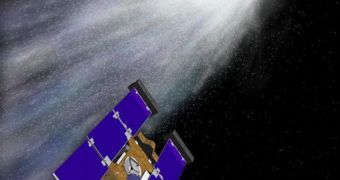A NASA spacecraft launched on February 7, 1999 is current getting ready to conduct yet another flyby in its long-duration mission, this time of comet Tempel 1. Originally, the mission was called Stardust, and its goal was to carry out a flyby of comet Wild 2.
This was a sample-return mission. The spacecraft flew through the comet's coma tail, and opened the doors to its sample chambers. It was able to collect some amounts of cometary particles, which it then parachuted safely to Earth.
The primary flyby took place in January of 2004, and the sample chamber was returned to the Utah Test and Training Range two years later. Because the spacecraft had life in it still, it was reassigned to carry out other tasks in the solar system.
Now, it is reassigned to the Stardust-NExT mission, which stands for New Exploration of Tempel 1. At this time, the rendezvous between the two is expected to take place on February 14, 2011, and the probe's main mission is to collect high-resolution images of the comet.
Also high on the priority list is an imaging experiment that calls for Stardust-NExT to image a crater made on the surface of Tempel 1 by the Deep Impact impactor stage. The instrument slammed into its target back in July 2005.
When that happened, the Deep Impact spacecraft could not observe the newly-formed crater, on account of the fact that a very large cloud of debris was formed following the impact.
But the dust most likely settled until then, and so the new flyby is bound to bring experts operating the re-purposed Stardust spacecraft new data on what Tempel 1 is made up of.
Tom Duxbury, an expert at the NASA Jet Propulsion Laboratory (JPL), in Pasadena, California, was the project manager for Stardust operations, and is now the project manager for the NexT mission.
Allan Cheuvront, who is based at Lockheed Martin Space Systems, is the Stardust-NExT program manager. The corporation was the primary contractor for this mission.
“I'm confident that we'll be in good shape. We'll get the images and we'll provide brand-new science. This has been a remarkable, robust spacecraft. It has done everything we've asked it to do and more,” Cheuvront says, quoted by Space.
“Scientists don't understand the rotation mechanism of the comet, why it changes, what causes it to change, and how to predict that,” he adds, quoted by Space.
“We did everything we can to put ourselves in a position to get a picture of the crater. But there are so many unknowns […] we have to be lucky. Hopefully the comet will cooperate,” he concludes.

 14 DAY TRIAL //
14 DAY TRIAL //